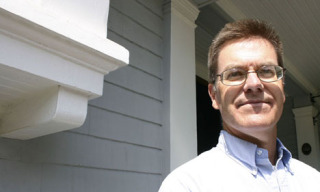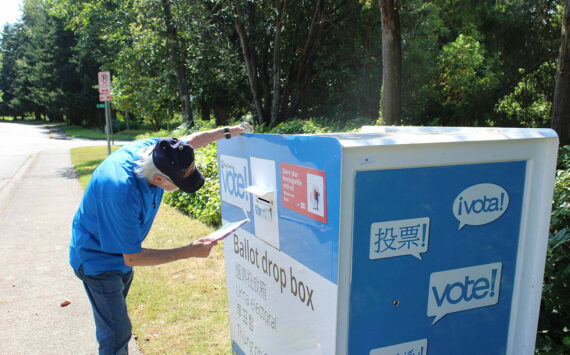When sifting back through Tacoma’s history, one valuable resource is the City of Tacoma’s register of historic places. The list includes nearly 150 properties spanning from the 1870s to the 1950s.
An equally valuable resource could be the city’s trees. Tacoma is home to many so-called “heritage trees” that date back to the late-1890s and early-1900s.
According to the city’s urban forester, Ramie Pierce, an effort is under way to overhaul the city’s street tree ordinance that could include the creation of a register of historic trees. “It seems like [Tacoma] is old enough now,” says Pierce. “Why don’t we have this? Other people have requested a similar program, so I know there is interest.”
One person who would like to see a register of historic trees is North Slope Historic District resident and preservation activist Marshall McClintock. He has spent hours in the Northwest Room at the Tacoma Public Library searching through archives that document the city’s street beautification projects. He’s also consulted “Champion Trees of Washington State” by Robert Van Pelt to learn more about heritage trees.
McClintock, who also serves as chair of the North Slope Historic District’s board of directors, has identified three trees in and around the North Slope that could be added to the register if it’s created.
Yesterday, the Tacoma Daily Index published a news feature on the issue of creating a heritage register of trees.
Today, we discuss the issue with McClintock.
TACOMA DAILY INDEX: Tell me about your interest in seeing Tacoma create a register of historic trees.
MARSHALL MCCLINTOCK: It sounds kind of odd when you first mention it. But there are what are known as Champion Trees — these are the trees that are the largest of their species. A program was started nationwide to identify the champion trees in each state. Of course, Washington has been a part of that effort. Tacoma is the home of a number of Champion Trees. Some of them are located in parks, like Wright Park. But many of them are located in home properties, or in the parking strip between the sidewalk and the street. The parking strip is a rather ambiguous area because it’s legally owned by the city, but homeowners are required to maintain it. We have several Champion Trees in the parking strips here in the North Slope. We would like to make sure they are protected, and they remain as long as they are viable trees. Trees, obviously, are living things. They’re not like buildings. They do have a life cycle and they do eventually die. What we would like to avoid is a situation where the city, or a homeowner, basically decides, ‘Oh, we’re just going to get rid of that.’ I’m working on a nomination for three Champion Trees we have in the district. The City is aware of this issue and they are working on what is essentially a register of trees, or something along the line of a registry of Champion Trees, historic trees, or important trees. It would allow a certain amount of protection allotted to trees of a certain size or character, not only in our neighborhood but throughout the city. We just think these trees become icons in the neighborhood.
INDEX: You mentioned three Champion Trees in the North Slope Historic District. Where are they?
MCCLINTOCK: One of them is the largest Cedar of Lebanon in the State of Washington. It happens to stand inside the second Rust Mansion, the large one down on North I Street, and it was probably part of the landscaping that was done for the Rust Mansion at the time. The other one is the second largest Spanish Chestnut in Washington State. It sits in a parking strip up on Sheridan and Fifth, and is one we are worried about because of its location on the parking strip. The third tree is a Catalpa tree located next to Frisko Freeze. It has a beautiful broad leaf on it, and a rather long, bean-shaped seed pod that appears, and beautiful fragrant flowers. It’s a very popular street tree, but you don’t see too many these days.
INDEX: When a building is added to the city’s historic register, someone submits the nomination, it is reviewed by the city’s landmarks commission, which may then forward it on to City Council to be added to the register. Do you envision a similar process for historic trees?
MCCLINTOCK: My guess is it would be somewhat similar. There is already a city arborist, and the landmarks preservation commission is already in place. There might be some combination of the city arborist saying it’s worthy of being included, and the landmarks preservation commission reviewing the nomination and so forth. So it probably would have some similarity. But the same kind of criteria would not necessarily apply. It could just be simply that’s its one of the registered Champion Trees because there is a program in place already in Washington State.
INDEX: Have you heard any support or opposition for the idea?
MCCLINTOCK: I haven’t heard of any opposition. That might appear later on when it gets more fully developed. Right now, mostly what we hear from people is they support it. These trees are recognized and people sort of consider them to be iconic and so forth, and people know, ‘Oh, the big Chestnut tree.’ They are aware of that. In fact, I think they would probably want to register more of them. I get a number of calls from people who are upset when large trees are taken down. Of course, when we get greater density in our city, it’s an issue that is coming to the fore now. There’s a move, both in Seattle as well as Tacoma, to protect and enhance the tree cover in the city. That’s an important part of wastewater management, as well as just improving the urban environment.
INDEX: You mentioned three Champion Trees in the North Slope. Do you have any idea how old they are?
MCCLINTOCK: It’s hard to say. One thing that people tend to forget is that the Northwest is a fantastic tree-growing environment. Trees that like in our climate can grow really fast, and get quite large in a protected urban environment, assuming they don’t run afoul of saw-wielding humans. The Cedar of Lebanon at the Rust mansion was probably planted as part of the original landscaping of the house, so that would put it being planted in 1905. Of course, as nursery stock, it would have been several years old at the time of planting. And, given its important Biblical connections, we can’t rule out the possibility that it might have been brought back from the Middle East as a gift or souvenir. Botanical import restrictions were non-existent at the time. The Catalpa and Spanish Chestnut trees were probably planted sometime between 1890 and 1910 as part of one of the city’s street beautification projects. They are classic landscape trees of the period – not appropriate with asphalt pavement and concrete sidewalks but those came later. Ebenezer Roberts, the city’s first parks superintendent from 1890-1910, did most of the landscape plantings at Wright and Point Defiance parks. He established greenhouses and a tree nursery at Point Defiance, and made street trees available to residents. The city has a similar program still in operation to day. Street beautification projects (primarily planting trees) along with Arbor Day festivals and ceremonial tree planting were all part of the “city beautiful” movement. This was one of the Progressive Era’s many improvement projects. In the older eastern cities, city beautification was done to mitigate the harsh urban cityscape that came with the second industrial revolution (i.e. Dickenesque tenements, etc). In the West it was more about domesticating or civilizing wilderness: clear cut the native forest, layout a town, and then plant primarily non-native trees to create a landscaped, garden-like setting.


Todd Matthews is editor of the Tacoma Daily Index and recipient of an award for Outstanding Achievement in Media from the Washington State Department of Archaeology and Historic Preservation for his work covering historic preservation in Tacoma and Pierce County. He has earned four awards from the Society of Professional Journalists, including third-place honors for his feature article about the University of Washington’s Innocence Project; first-place honors for his feature article about Seattle’s bike messengers; third-place honors for his feature interview with Prison Legal News founder Paul Wright; and second-place honors for his feature article about whistle-blowers in Washington State. His work has also appeared in All About Jazz, City Arts Tacoma, Earshot Jazz, Homeland Security Today, Jazz Steps, Journal of the San Juans, Lynnwood-Mountlake Terrace Enterprise, Prison Legal News, Rain Taxi, Real Change, Seattle Business Monthly, Seattle magazine, Tablet, Washington CEO, Washington Law & Politics, and Washington Free Press. He is a graduate of the University of Washington and holds a bachelor’s degree in communications. His journalism is collected online at wahmee.com.








